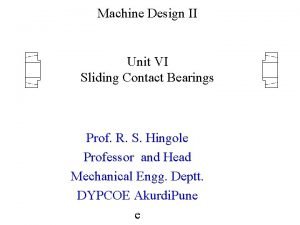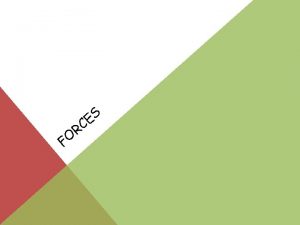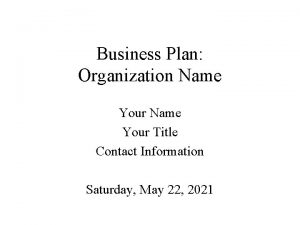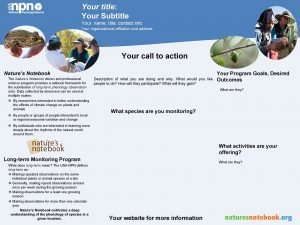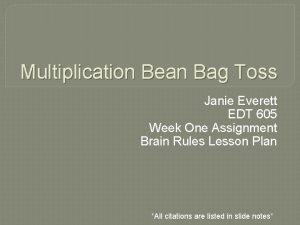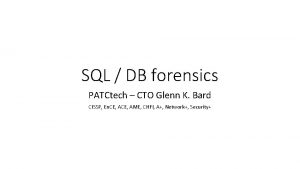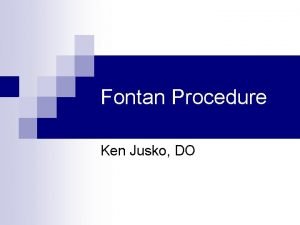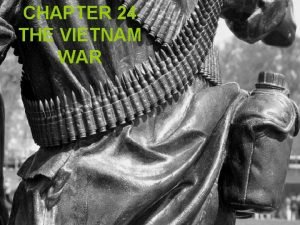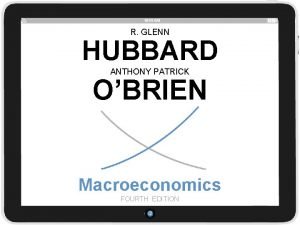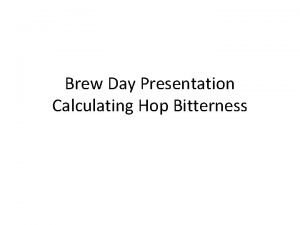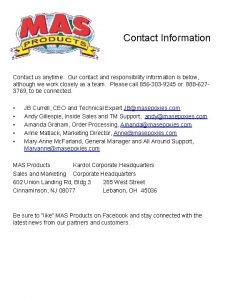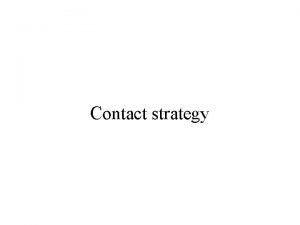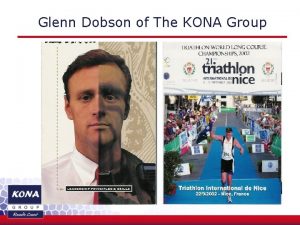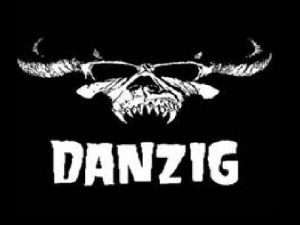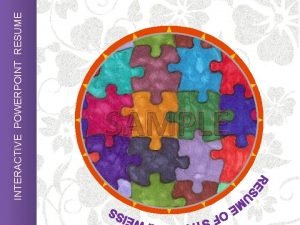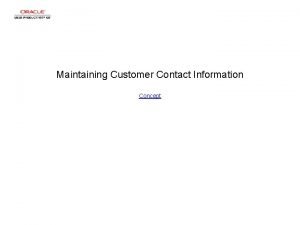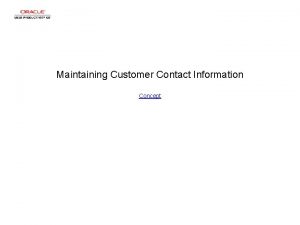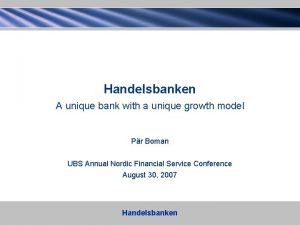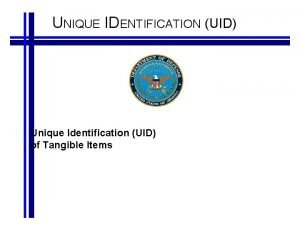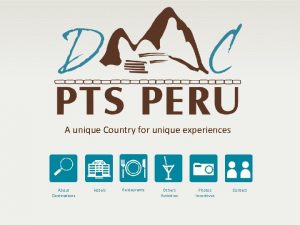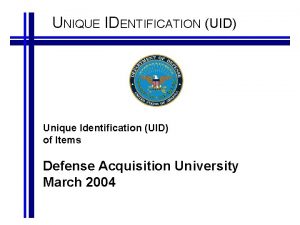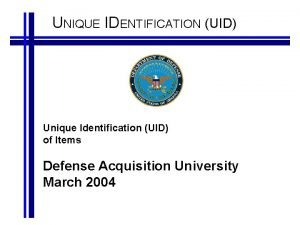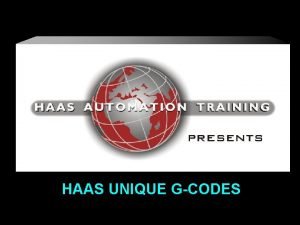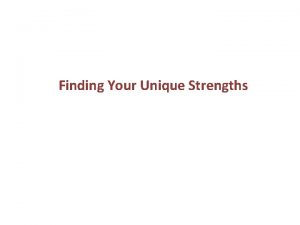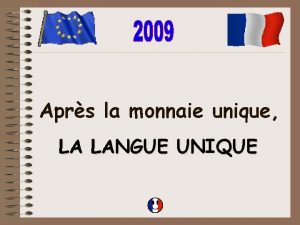Unique Applications of NX 1 Contact Information Glenn


































- Slides: 34

Unique Applications of NX 1

Contact Information Glenn Brzyski Moog Inc. East Aurora, NY 14052 E-mail: gbrzyski@moog. com Phone: 716 -687 -7642 2

Bio 29 years as a Designer/Drafter On the job training 21 years with Moog Inc. Started with 2 D CAD system (Cadra) Evolved to 3 D CAD system (Unigraphics V 11) 11 years on Unigraphics/NX Certified by ASME to Y 14. 5 M-1994 standard in 2005 as Geometric Dimensioning and Tolerancing Professional Senior (GD&TP)

Who Is Moog? The Moog I work for is Not: the synthesizer company the auto parts company 4

Who is Moog? Moog Inc. is a worldwide designer, manufacturer, and integrator of precision control components and systems. Our highperformance systems control military and commercial aircraft, satellites and space vehicles, launch vehicles, missiles, automated industrial machinery, marine applications, and medical equipment. Moog provides innovative actuation solutions and space-rated electronics for launch vehicle applications. We have extensive experience with electrohydraulic, electromechanical and electrohydrostatic actuation systems and also provide fluid and gas control products for the main propulsion and roll control systems and rocket engines. Moog’s systems and components equip such vehicles as the Space Shuttle, International Space Station, Delta IV, Atlas V, and Ariane 5. 5

What I really work on ARES I Roll Control Thruster Valve

Kayak and Propeller Projects

Kayak History Why did I create a kayak? What’s the magic? Wanted to design my own Was it possible? What tools were conveniently available? NX 4 8

Method Used Top Down Assembly Structure Each form was created as a component as seen from the Assembly Navigator Design Intent is propagated to each of the kayak forms when changing the following: Overall Beam Length (Width) Designed Waterline (Draft) Sheer Angle Chine Angle Side Top Profile (Buttocks) Profile (Plan-form)

Tools Used Datum Csys Offset Datum Planes Sketcher Copy Feature/Paste Mesh Surface Shell Wave Geometry Linker Modeling Spreadsheet (Excel)

Datum Coordinate System (Datum Csys) Insert > Datum/Point > Datum CSYS It represents the starting point for all of the offsets found normally in boat construction Datum Csys is a collection of (3) datum planes, (3) datum axes, an a origin point, all in one feature in the Part Navigator In this case, it resides on absolute (0, 0, 0) in the part file All datum planes that contribute to the shape of the kayak are offset from this (Designed Waterline, Sheer Angle, etc. )

Offset Datum Planes Created the necessary spacing of the forms (12” on center) Created the “Designed Waterline” datum plane offset from the Datum Csys Designed Waterline datum plane

Sketcher Multiple Sketches with the same geometry (forms) were used (5 arcs and 4 lines) Side profile (Buttocks) and Top Profile (Plan-form) were created Sheer and Chine sketches were also created to develop the shape of the hull and deck Top Profile Sketch Form Sketches Side Profile Sketch

Sketcher Tip Two different sketches that are attached on datum planes orientated 90 degrees from each other can be inter-related geometrically by the use of points that are Coincident The creation or Timestamp order of the sketches is important The sketches can only be linked in this manner if Positioning Dimensioning and a Fixed Point are not used Coincident points

Copy Feature/Paste Edit > Copy Feature or Copy > Paste Allowed very quick copying of the original sketch without starting from scratch each time Sketches were pasted with new expressions and as a new parent

Mesh Surface Through Curves function created the shape of the hull as a solid body Selection of the individual section strings must be consistent in order to get the proper result In this case, the arrows defining the direction of the individual sections string point in the same direction

Shell Formerly called “Hollow” in Unigraphics V 18 Insert > Offset Scale > Shell Allows the inside shape of the hull to conform to the outside with a consistent wall thickness (. 25”)

Wave Geometry Linker Linked Sketches from the top level assembly were pushed down to each of their respective components so that solid bodies could be created All geometry will be updated when the Design Intent is changed (ex: Overall Length)

Modeling Spreadsheet (Excel) Expressions were imported In the Modeling Spreadsheet: Tools > Extract Expr (Expressions) Calculations were made using full Excel functionality Solid model was updated: Tools > Update NX Part

The Results 20

Propeller History Why did I create a fixed pitch wooden propeller? What’s the magic? Wanted to make the best selection possible for the type of airplane that it is being used on Was it possible? What tools were conveniently available? NX 4 Brothers Harry, Martin and Ira (left to right) Sensenich were ahead of their time in snow transportation. They made this snowmobile in the late 1920 s to retrieve family mail from a box that was half a mile away from their home on the Kissel Hill Road. The propeller that helped power the machine was bought, and when it broke, they decided to start making their own out of wood. This led to Harry and Martin founding the Sensenich Brothers Propeller Company.

Method Used Top Down Assembly Structure Design Intent changes are propagated down to the fixture which checks the profile and shape of the blade Checking Fixture

Type of Aircraft

Tools Used Datum Csys Offset Datum Planes Sketcher Copy Feature/Paste Studio Spline Mesh Surface Wave Geometry Linker Modeling Spreadsheet (Excel)

Datum Coordinate System (Datum Csys) Datum Csys resides on absolute (0, 0, 0) of the part file Geometry for the propeller is positioned at the Y axis and symmetrical to the datum plane shown Design Intent is to have all changes in size and shape emanate from the Datum Csys Axis used Datum Plane used

Offset Datum Planes Created the necessary spacing of the airfoils (offsets based on 10% intervals from root to tip) Datum plane angles are based on a previous sketch (Blade Angle Diagram) using Geometric Expressions

Sketcher Multiple sketches with the same airfoil sections were used and modified as the twist of the prop approached the root Airfoil sketches Airfoil changed shape from flat bottom at the tip for 60% of the blade to being fully symmetrical at the hub Blade plan-form shape sketch was also created Plan-form sketch

Copy Feature/Paste Allowed quick copying and placement of the original airfoil sketch without starting from scratch each time Sketches can be linked to each other or treated as new parents depending on Design Intent Sketches were pasted as new parents and linked to the appropriate expressions and geometry

Studio Spline Insert > Curve > Studio Spline “Connected the dots” of the points of each of the airfoil sketches Associative to the points Used for the Through Curves function Studio Splines

Mesh Surface Through Curves function was used to create the solid geometry

Wave Geometry Linker Linked Bodies of the propeller were pushed down to each of the fixture components and then subtracted from the extrusions This provided a view on a drawing of each airfoil which can be later transferred to the profile checker fixture made of plywood

Modeling Spreadsheet (Excel) Expressions were imported In the Modeling Spreadsheet: Tools > Extract Expr (Expressions) Calculations were made using full Excel functionality Solid model was updated: Tools > Update NX Part

The Results

Questions?
 Which force
Which force Which of the following is sliding contact bearing
Which of the following is sliding contact bearing Which is a contact force? *
Which is a contact force? * Non-contact forces portfolio
Non-contact forces portfolio Irritant contact dermatitis vs allergic contact dermatitis
Irritant contact dermatitis vs allergic contact dermatitis Is gravity a noncontact force
Is gravity a noncontact force Schottky contact vs ohmic contact
Schottky contact vs ohmic contact Difference between high contact and low contact services
Difference between high contact and low contact services Contact vs noncontact forces
Contact vs noncontact forces Contact and non contact forces
Contact and non contact forces Contact information title
Contact information title Title contact information
Title contact information Janie bean phone number
Janie bean phone number Metoda glenna domana
Metoda glenna domana Patctech
Patctech Glenn cirurgia
Glenn cirurgia Teoría de faye glenn abdellah
Teoría de faye glenn abdellah Glenn york elementary
Glenn york elementary Glenn bard
Glenn bard Glenn bard
Glenn bard Hemi fontan
Hemi fontan Deirdre glenn enterprise ireland
Deirdre glenn enterprise ireland Glenn nathan
Glenn nathan Glenn christie
Glenn christie Glenn andreotta
Glenn andreotta Glenn okun
Glenn okun Glenn heirman
Glenn heirman Glenn york elementary
Glenn york elementary Glenn hoffman umb
Glenn hoffman umb Glenn samaai
Glenn samaai Glenn hubbard inside job
Glenn hubbard inside job Allic
Allic Glenn parker huntsville al
Glenn parker huntsville al Redaction criticism definition
Redaction criticism definition Glenn tinseth
Glenn tinseth

